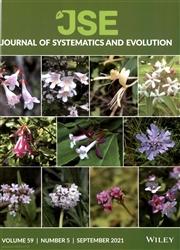弄清地中海盆地胡颓子科(Cardueae, Compositae)胡颓子属(Carthamus-Carduncellus complex)的起源和多样性
IF 2.9
1区 生物学
Q1 Agricultural and Biological Sciences
引用次数: 0
摘要
要了解地中海盆地生物的丰富性和多样化过程,既需要了解当前环境的复杂性以及古地理和古气候事件,也需要从引入时间维度的研究中获取信息。荠菜科(Cardueae, Compositae)是研究该地区生物地理历史的一个很好的案例,因为它是在整个盆地中演化的。我们根据之前对该复合体几乎完整的类群取样进行的系统发育研究,对其进行了分子测年、祖先区域估计和分化分析。我们的主要目的是确定构造和气候事件在该复合群断裂过程中的作用,以及两个主系(Carduncellus s.l.和 Carthamus)的扩张路线。我们的研究结果表明,该复合群的主要品系起源于中新世。之后,地中海盆地新近纪和更新世期间发生的所有主要古地理和古气候事件都对该复合群的进化史产生了重要影响。梅西尼亚盐度危机促进了Carduncellus属从北非向伊比利亚半岛的扩散,并使Phonus属和Femeniasia属从Carduncellus属中分离出来。上新世地中海气候的出现以及一些造山过程可能是造成Carduncellus属多样化的主要原因。与此相反,更新世的冰川作用在荠属的物种多样化中起到了关键作用。此外,我们还强调了二次测定所产生的问题,以及之前对 Cardueae 科进行的两次测年分析之间存在的差异。本文章由计算机程序翻译,如有差异,请以英文原文为准。
Untangling the origin and diversification of the Carthamus–Carduncellus complex (Cardueae, Compositae) in the Mediterranean basin
Understanding the richness and diversification processes in the Mediterranean basin requires both knowledge of the current environmental complexity and paleogeographic and paleoclimate events and information from studies that introduce the temporal dimension. The Carthamus–Carduncellus complex (Cardueae, Compositae) constitutes a good case study to investigate the biogeographic history of this region because it evolved throughout the basin. We performed molecular dating, ancestral area estimation, and diversification analyses based on previous phylogenetic studies of a nearly complete taxon sampling of the complex. The main aims were to determine the role of tectonic and climatic events in the disjunction of the complex and the expansion route of the two main lineages, Carduncellus s.l. and Carthamus . Our results suggest that the main lineages in the complex originated during the Miocene. Later, all main paleogeographic and paleoclimatic events during the Neogene and Pleistocene in the Mediterranean basin had an important imprint on the evolutionary history of the complex. The Messinian Salinity Crisis facilitated the dispersion of the genus Carduncellus from North Africa to the Iberian Peninsula and the split of the genera Phonus and Femeniasia from the Carduncellus lineage. The onset of the Mediterranean climate in the Pliocene together with some orogenic processes could be the main causes of the diversification of the genus Carduncellus . In contrast, Pleistocene glaciations played a key role in the species diversification of Carthamus . In addition, we emphasize the problems derived from secondary dating and the existing differences between two previous dating analyses of the tribe Cardueae.
求助全文
通过发布文献求助,成功后即可免费获取论文全文。
去求助
来源期刊

Journal of Systematics and Evolution
Agricultural and Biological Sciences-Ecology, Evolution, Behavior and Systematics
CiteScore
7.40
自引率
8.10%
发文量
1368
审稿时长
6-12 weeks
期刊介绍:
Journal of Systematics and Evolution (JSE, since 2008; formerly Acta Phytotaxonomica Sinica) is a plant-based international journal newly dedicated to the description and understanding of the biological diversity. It covers: description of new taxa, monographic revision, phylogenetics, molecular evolution and genome evolution, evolutionary developmental biology, evolutionary ecology, population biology, conservation biology, biogeography, paleobiology, evolutionary theories, and related subjects.
 求助内容:
求助内容: 应助结果提醒方式:
应助结果提醒方式:


